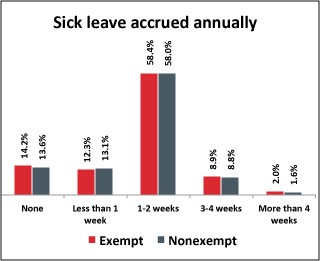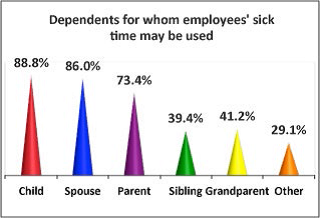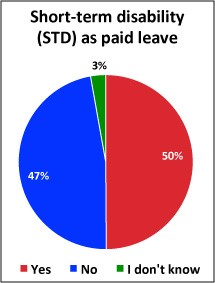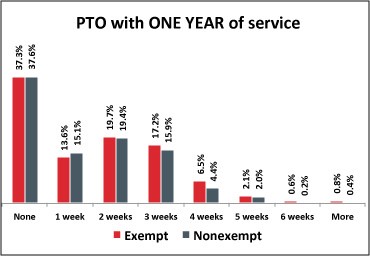 |
- Paid time off (PTO) is available to 96.6% of those responding to our survey.
- Paid sick leave is an option for 83.8% (slightly up from 82.7% in 2014).
- Paid personal days are available for only 39.5% of employees (down from 44.7% in 2014).
- Vacation and sick leave are computed separately by 63.4% of participants (64.1% in 2014).
Thanks to all 1,431 participants! Here are the detailed results.
Who Participated?

A total of 1,431 individuals, with 79% at manager level or above, participated in this survey, which was conducted in August 2015. Of those who identified themselves, 58.3% represent privately owned for-profit companies, 10.1% are with public entities, and 31.5% work for government or nonprofit organizations.
Companies with 1–250 employees account for 60.9% of survey participants. Companies with 251–500 employees make up 13.8%, and organizations with 501–1,000 comprise 9.3%. Rounding out the group, companies with more than 1,000 employees account for 16% of survey participants.
Over half (66.4%) of the participants are in service industries; 21.2% are in agriculture, forestry, construction, manufacturing, or mining; 9.2% are in wholesale, retail, transportation, or warehousing; and 3.3% are in real estate or utilities.
Handle FMLA like a pro! Start on Monday, November 16, 2015, with a new interactive webinar—Beyond FMLA Basics: How to Handle Complex Tracking and Other Employee Leave Challenges. Learn More
Leave Types

Much like last year (98.9%), this year’s survey shows that 99.4% of participants offer some form of time off to employees. Paid vacation time, separately or as PTO, is available to 96.6% of those responding to our survey, while paid sick leave is an option for 83.8% (slightly up from last year at 82.7%); and paid personal days are available for 39.5% (down a bit from last year’s 44.7%). Vacation and sick leave are computed separately by 63.4% (64.1% in 2014) and as part of a PTO plan by 36% (35.6% in 2014).
Bereavement leave is offered by 84.4% (82.1% in 2014), and 89.4% (90.1% last year) offer 6 or more paid holidays per year. Extended medical leave is offered by 59.2% (58.2% in 2014), and maternity/paternity leave is offered separate from other sick leave by 28.1% (28.6% last year).
Flagged by 13% of survey participants, our favorite catchall “other” mostly contains fairly standard leave types, including maternity/paternity leave, holidays, wellness, military leave, jury duty, compensatory time off, and employee birthday. It also contains a few less known types of leave, for example:
- Longevity leave
- Terminal leave (half of sick leave balance just before retirement)
- Sport representation leave
- Pilgrimage leave for Muslims (5 days every 3 years)
- Marriage and moving day
- Injury in line of duty leave
- Military reintegration
- K–12 leave
- Medical donor
- Piomingo Day
- Crisis leave
- Medical escort leave
Vacation

The first year of employment provides 2 weeks of vacation time to both exempt and nonexempt employees for the majority of our survey respondents at 58.3% and 58.7%, respectively. One week is offered to exempt employees for 16.1% and to nonexempt employees for 22%. Three weeks or more is provided to exempt employees for 11.8% and 8.8% offer 3 weeks or more to nonexempt employees.
Five years of employment provides exempt employees with 3 weeks of vacation for 55% (55.6% in 2014 and 52% in 2013) of survey participants, and 54% (56.1% in 2014 and 53.6% in 2013) provide nonexempt employees with 3 weeks. Four weeks or more is provided to exempt employees for 11.3% (15.2% in 2014 and 20% in 2013) and to nonexempt employees for 7.4% (10% in both 2014 and 2013). No vacation is provided to exempt employees for 2.5% (1.3% last year) of our respondents, and 1.9% (2% in 2014) provide zero vacation to nonexempt employees.
Ten years of employment provides exempt employees with 4 weeks of vacation for 40.5% and brings nonexempt employees the same for 41.8%. Four weeks is provided to exempt employees for 41.1% and to nonexempt for 39%. Five weeks or more is provided to exempt employees for 8.5% (7.8% in 2014 and 10.2% in 2013) and to nonexempt employees for 5.8% (5.6% in 2014 and 7.7% in 2013).
Fifteen years of service grants exempt employees 4 weeks of vacation for 53.3% (53% last year) and brings nonexempt employees the same for 51.5% (52.2% in 2014). Five weeks or more is provided to exempt employees for 14.2% (14.7% last year) and to nonexempt employees for 12.2% (12.6% in 2014).
Exempt employees with more than 15 years of service receive 3 weeks of vacation for 21% and 22.9% for nonexempt employees. Four weeks is provided to exempt employees at 53.3% (56.6% in 2014), and 51.5% (57.5% in 2014) provide the same for nonexempt employees. Five weeks of vacation time is provided to exempt employees for 14.2%, and 12.2% provide that same amount of vacation time to nonexempt. No vacation, however, is provided to exempt employees for 2.7% (3.2% in 2014) of our respondents, and 2.2% (3.7% last year) provide zero vacation to nonexempt employees.
Sick Time

Less than 1 week is the amount of sick leave provided to exempt employees for 12.3% (13.2% last year) of our respondents who offer this benefit, and nonexempt employees receive the same for 13.1% (14.5% in 2014). Exempt employees receive 1 to 2 weeks per year for 58.4% (60.8% in 2014) of survey participants, and nonexempt employees receive the same for 58% (60.4% last year). Exempt employees have 3 to 4 weeks per year for 8.9% (9.1% last year), and nonexempt employees get that amount for 8.8% (7.6% last year). More than 4 weeks per year is the norm for exempt employees at 2% (2.5% last year) and for nonexempt employees at 1.6% (2% in 2014).

Employees may use sick time to care for a dependent child for 88.8% who answered this question, and 86% allow its use to care for a sick spouse, while 73.4% allow use of employee sick time to care for a sick parent. It starts to drop when employees need time off to care for a sibling (39.4%) or to care for an ill grandparent (41.2%). At 29.1%, “other” is a mixed bag that includes:
- Any relative living with the employee or that the employee has responsibility for, 16%
- Domestic partners, 11%
- In-laws, 10.5%
- Anyone or anything the employee wants (almost all due to use of PTO vs. sick time), 8.5%
- Dependents defined by the state or federal Family and Medical Leave Act (FMLA), 8.5%
- Anyone living in the same household as the employee, 6%
- Immediate family members, 4%
- Grandchildren, 3.5%
- Step-relatives, 3%
- Aunts and uncles, 1%
- Pets, 1%
- Neighbors, .05%
FMLA regulations making your life a nightmare? Join us Monday, November 16, 2015, for a new interactive webinar, Beyond FMLA Basics: How to Handle Complex Tracking and Other Employee Leave Challenges. Earn 1.5 hours in HRCI Recertification Credit and 1.5 hours in SHRM Professional Development Credit. Register Now
Disability Leave
Paid short-term disability (STD) leave is provided by 49.9%, with leave of fewer than 30 days the rule for 10.9% of survey participants who responded to this question. STD leave of 31–90 days is available to 48% (45.6% in 2014), and 91–180 days is allowed for 35.9% (40.4% last year). When it comes to how much of STD leave is paid, 67.4% (64.9% in 2014 and 59.6% in 2013) cover 51%–75% of employees’ base pay, and 16% (16.6% in 2014 and 20.4% in 2013) cover 76%–100%.

Paid long-term disability (LTD) leave is a benefit for 54.6% (47.8% last year), with leave of more than a year available for 52.2% (55.6% last year and 51.3% in 2013) of survey participants who answered this question. LTD of 6 months to a year is an option for 15.4% (16.3 in 2014 and 17.8% in 2013), and 4 to 6 months of paid LTD is available for 12.6% (13% in 2014), while 2 to 4 months is a benefit for 13.4%. LTD pay covers 51%–70% of base pay for 76.3% (81% in 2014 and 75.1% in 2013) and 26%–50% of base pay for 11.3% (10.3% last year and 11.9% in 2013).
PTO

One year of employment earns exempt employees 1 week of PTO for 13.6% and 2 weeks for 19.7%. The same length of service provides nonexempt employees with 1 week of PTO for 15.1% and 2 weeks for 19.4%. Three weeks is offered by 17.2% to exempt employees, and 15.9% offer 3 weeks to nonexempt employees. PTO of 4 weeks or more is provided to exempt employees for 10.1% and to nonexempt employees for 7%.
Five years of employment provides exempt employees with 3 weeks of PTO for 16.2% (18.2% in 2014) of survey participants, and 16.9% (19.1% last year) provide nonexempt employees with 3 weeks. Four weeks or more is provided to exempt employees for 29.3% (16.4% last year) and to nonexempt employees for 24.2% (15.1% in 2014).
Ten years of employment brings 4 weeks of PTO to exempt employees for 16.8% and the same to nonexempt employees for 16.4% of those who responded to this question in our survey. Five weeks or more is provided to exempt employees for 24.3% and to nonexempt employees for 20%.
Fifteen years of service gets exempt employees 4 weeks of PTO for 15.6% and brings nonexempt employees the same for 15.3%. Five weeks or more is provided to exempt employees for 28.6% (15.1% in 2014) and to nonexempt employees for 24.6% (14.7% last year).
Exempt employees with more than 15 years of service receive 5 weeks of vacation for 16.7% who answered this question, and 14.9% provide the same for nonexempt employees. Employees who are exempt receive 6 weeks or more PTO, however, for 15.5%, and nonexempt receive the same for 13.1%.
Tomorrow, more results from the 2015 Employee Leave Survey. Plus, an introduction to an interactive webinar, Beyond FMLA Basics: How to Handle Complex Tracking and Other Employee Leave Challenges.
